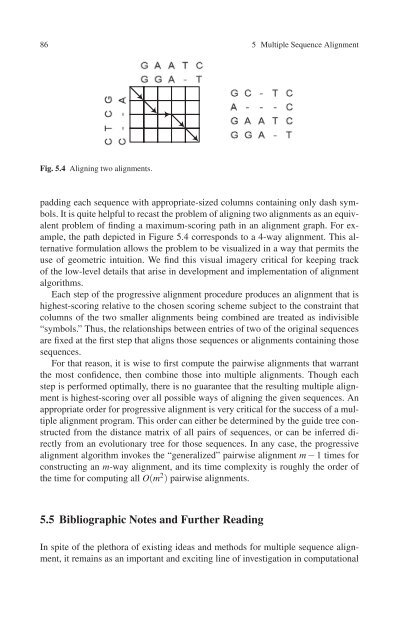Create successful ePaper yourself
Turn your PDF publications into a flip-book with our unique Google optimized e-Paper software.
86 5 Multiple <strong>Sequence</strong> Alignment<br />
Fig. 5.4 Aligning two alignments.<br />
padding each sequence with appropriate-sized columns containing only dash symbols.<br />
It is quite helpful to recast the problem of aligning two alignments as an equivalent<br />
problem of finding a maximum-scoring path in an alignment graph. For example,<br />
the path depicted in Figure 5.4 corresponds to a 4-way alignment. This alternative<br />
formulation allows the problem to be visualized in a way that permits the<br />
use of geometric intuition. We find this visual imagery critical for keeping track<br />
of the low-level details that arise in development and implementation of alignment<br />
algorithms.<br />
Each step of the progressive alignment procedure produces an alignment that is<br />
highest-scoring relative to the chosen scoring scheme subject to the constraint that<br />
columns of the two smaller alignments being combined are treated as indivisible<br />
“symbols.” Thus, the relationships between entries of two of the original sequences<br />
are fixed at the first step that aligns those sequences or alignments containing those<br />
sequences.<br />
For that reason, it is wise to first compute the pairwise alignments that warrant<br />
the most confidence, then combine those into multiple alignments. Though each<br />
step is performed optimally, there is no guarantee that the resulting multiple alignment<br />
is highest-scoring over all possible ways of aligning the given sequences. An<br />
appropriate order for progressive alignment is very critical for the success of a multiple<br />
alignment program. This order can either be determined by the guide tree constructed<br />
from the distance matrix of all pairs of sequences, or can be inferred directly<br />
from an evolutionary tree for those sequences. In any case, the progressive<br />
alignment algorithm invokes the “generalized” pairwise alignment m − 1 times for<br />
constructing an m-way alignment, and its time complexity is roughly the order of<br />
the time for computing all O(m 2 ) pairwise alignments.<br />
5.5 Bibliographic Notes and Further Reading<br />
In spite of the plethora of existing ideas and methods for multiple sequence alignment,<br />
it remains as an important and exciting line of investigation in computational

















